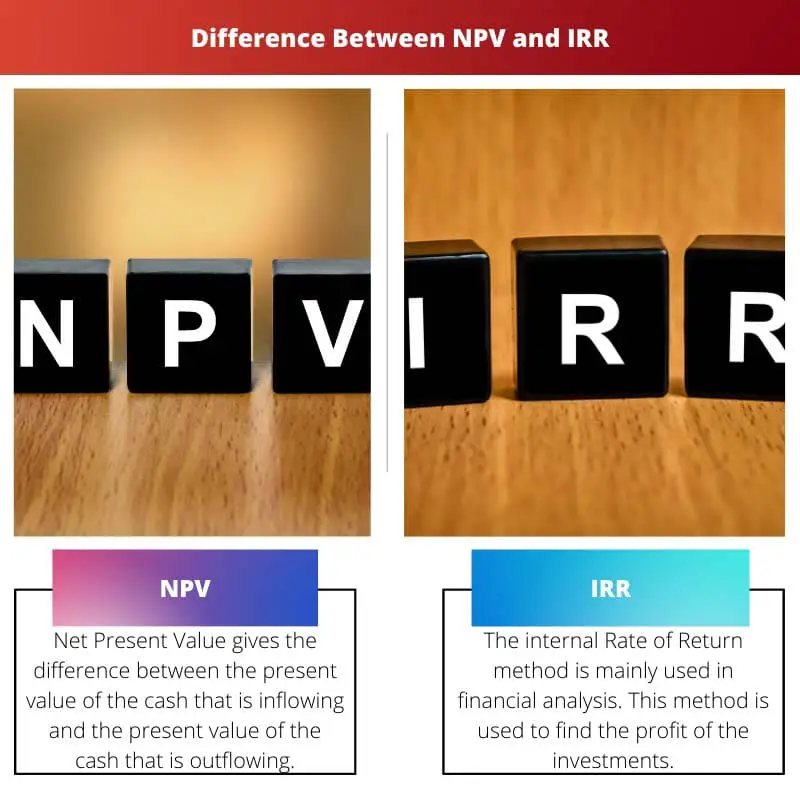Calculating the cash discount and its inflows and outflows is important for a company. It is specially taken care of when the company takes on some new projects. The company will be in a dilemma to find which method suits them the best for them.
NPV and IRR are used for finding discounted cash and are preferred depending on the problem.
Key Takeaways
- NPV (Net Present Value) evaluates the profitability of a project by calculating the present value of all cash flows, highlighting overall value creation.
- IRR (Internal Rate of Return) measures a project’s profitability by finding the discount rate at which the NPV becomes zero, indicating the break-even point.
- Both methods are used for investment appraisal, but NPV is more reliable in the case of non-conventional cash flows, while IRR might result in multiple or no solutions.
NPV vs IRR
NPV (Net Present Value) is a financial measure that calculates the present value of expected future cash flows from an investment. IRR (Internal Rate of Return) is another metric used to evaluate the profitability of an investment. The higher the IRR, the more profitable the investment can be.

There is a method to calculate net present value. For that, you have to estimate the cash flows of the future period, and then you have to determine the discounted rate.
This method is totally used to calculate the present or current value that comes as a future payment. This method uses the cost capital as the discounted rate.
IRR is mainly used for new projects that are taken by the company. They don’t want to take risks. So, they prefer the method over any other method. In order to make this method simpler, it will be calculated as the discounted cash inflows will be equated to discounted cash outflows.
Comparison Table
| Parameters of Comparison | NPV | IRR |
|---|---|---|
| Expansion | Net Profit Value | Internal Rate of Return |
| Can be expressed in | It can be expressed in absolute terms. | It can be expressed in percentage terms. |
| Decision-making status | Decisions can be made easily. | It will be of no use in decision-making. |
| Definition | Values of the cash flow in and out. | The rate at which the cash inflows will be equated with the cash outflows. |
| Advantages | It takes care of the investment size. | The rate of return is not required in this method. |
What is NPV?
Net Present Value gives the difference between the present value of the cash that is inflowing and the present value of the cash that is outflowing. This kind of method is used in capital budgeting and investment planning.
This is mainly used to analyze the project profitability or the amount that is invested in that project. It is used to find the value of the payments of future streams. If the net present value of the project invested is positive, then the cash that comes out of this will be positive and as well as attractive.
There is a formula to calculate net present value. One formula comes with the summation, and the other can be easily done without any summation. In business, the organization thinks of some plans to expand.
In that case, net present value is one of the effective and considered methods for expansion.
Net Present Value has many advantages, such as it takes the value of money and the time we invest, Comprehensive Tool, and Value of Investment. But there are certain limitations to using the net present value method.
They are Discounting Rates, and Different Projects are not Comparable, and Multiple Assumptions. If you are very confused about calculating net present value, you can also use the in-built clear taxes Calculator for NPV.

What is IRR?
The internal Rate of Return method is mainly used in financial analysis. This method is used to find the profit of the investments. The internal Rate of Return also uses the same formula that is used for net present value.
In net present value, it is kept as zero. But here, it is not kept as zero. It is somehow connected with one another as both deal with cash inflows and cash outflows. If we have a higher amount of internal rate of return, it will get good for the investment. It is used in various types of investments.
It is considered one of the best investment options when compared with other investment options in the market. We can even calculate the Internal Rate of Return in Excel.
Because in Excel, you don’t have to worry about the formula. It will do all kinds of work for you. You just have to enter the details and use the formula to arrive at the answer.
The internal Rate of the Method is the discount rate at which the net present value becomes zero. The primary goal of the Internal Rate of Return is to find the discount. There are several methods to do that, but the internal rate of return is one of the preferred methods for that.

Main Differences Between NPV and IRR
- The purpose of the NPV is to find the profit that is gained from the project. On the other hand, the purpose of the IRR is to determine either the profit or loss.
- The cash flows will be immediately reinvested at the cut-off rate in the NPV method, while the investment will be made at that time of the IRR method.
- If the time flows or any other discrepancy occurs, the cash flow of the internal rate of return will become negative, or there will be a lot of confusion. But that won’t happen in the NPV.
- When we invest more money initially, the profit will be high in NPV. But on the IRR, the profit will become higher or lower irrespective of the amount of money we invested.
- Due to the investment differences, most companies prefer the internal rate of return method.

- http://article.ajotab.com/html/10.11648.j.ajtab.20150102.13.html
- https://www.sciencedirect.com/science/article/pii/S1062976910000037

The information provided about the calculation of net present value and the use of IRR in financial analysis is very informative. It helps in understanding the practical application of these methods in real-world scenarios.
The detailed explanation of NPV and IRR, along with the comparison table, adds significant value to this article, making it a useful resource for understanding financial metrics.
I agree, the article effectively breaks down the concept of NPV and IRR, making it easier for readers to comprehend the nuances of these financial methods.
The article effectively delves into the details of NPV and IRR, providing a clear understanding of these financial concepts and their significance in investment decision-making.
I couldn’t agree more. The article offers practical knowledge and a comprehensive comparison of NPV and IRR, making it a must-read for anyone involved in financial analysis.
The clear explanation of NPV and IRR, along with their advantages and limitations, makes this article a valuable read for anyone interested in financial analysis and investment appraisal.
The practical examples and detailed comparison between NPV and IRR make this article a useful resource for professionals and students alike.
I couldn’t agree more. The article effectively highlights the importance of NPV and IRR in investment decision-making and provides a clear comparison of the two methods.
The article’s coverage of NPV and IRR, including their definitions, methods of calculation, and practical uses, is highly informative and beneficial for professionals and students alike.
The in-depth explanation of the net present value method, along with its advantages and limitations, makes the article a valuable resource for understanding investment appraisal and capital budgeting.
The article’s explanation of the calculation of net present value and the use of IRR is enlightening and offers practical knowledge for those interested in investment planning and financial analysis.
Absolutely, the article provides a detailed understanding of NPV and IRR through clear examples and comparisons, making it an educational read for anyone in the field of finance.
This article provides a comprehensive comparison between NPV and IRR, as well as a detailed explanation of each method. It also mentions the advantages and limitations of using the NPV method, giving us a clear understanding of the subject.
The detailed comparison table is very helpful in understanding the different parameters of NPV and IRR. It is a great resource for anyone looking to gain knowledge about these financial metrics.
I agree, the article gives a thorough explanation of NPV and IRR, making it easier to understand how they are used to evaluate investments in different scenarios.
The article accurately explains the process of calculating net present value and the significance of IRR, offering valuable insights into investment planning and financial decision-making.
The article’s emphasis on the advantages and limitations of NPV and IRR provides a well-rounded understanding of these financial metrics and their practical applications.
The explanations of NPV and IRR, as well as the comparison table provided in the article, make it easier to understand the differences and applications of these important financial metrics.
The article’s emphasis on understanding the decision-making status of NPV and IRR, along with the advantages of using NPV, provides valuable insights for financial analysis.
I found the article to be very informative in clarifying the definitions of NPV and IRR, and their practical usages in investment appraisal.
The formula for calculating net present value and the advantages and limitations of using NPV are well-explained in this article. It is essential to thoroughly understand these concepts for making informed investment decisions.
I found the explanation of the advantages and limitations of NPV very insightful. It’s important to consider these factors when analyzing investment opportunities.
Absolutely, the article does a great job of breaking down complex concepts into a clear and concise manner, making it easier for readers to grasp the information.